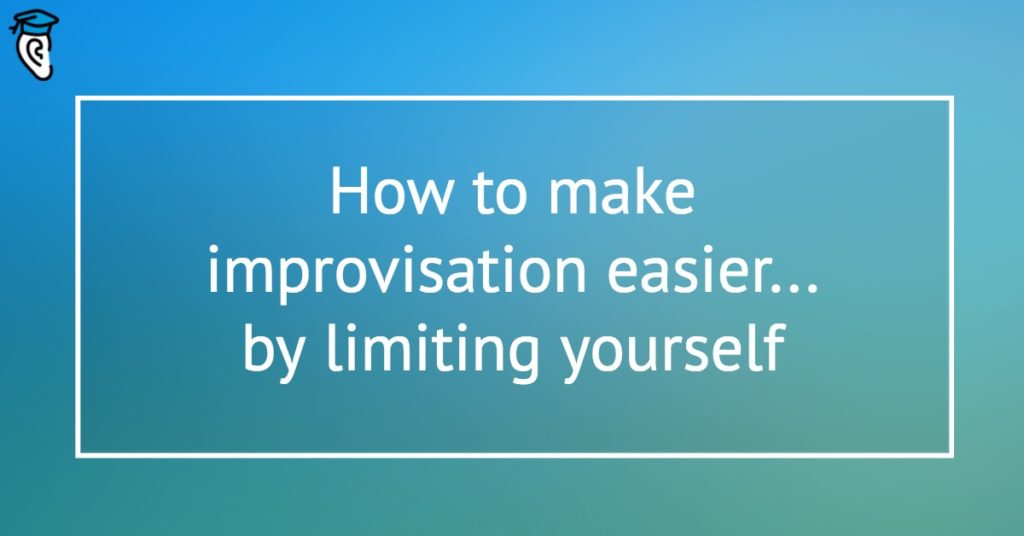Improvising music is normally either overwhelming – or boring. As a result many musicians avoid it, thinking they lack the “gift” to improvise freely. That’s just because they’ve been approaching it wrong and falling into one of two traps.
Improvisation feels overwhelming because at any moment, any note you can play is possible next! That leads to a paradox of choice where we feel paralysed and don’t know what to play.
The alternative is “beginner methods” of improvisation which typically prescribe specific formulas or patterns that you should follow to make sure your solo sounds “good”. It’s fun at first because you get a taste of improvisation but it quickly becomes boring as we blindly follow rules and patterns to stay “safe”.
The trick to getting the best of both worlds? Avoid overwhelm and escape the strict patterns by improvising based on “constraints”.
This is a summary post.
→ Read the full guide
The Improv Instinct
The improvisation “instinct” actually comes from practice and training. Anyone who seems like they just know which notes to play has actually worked hard to achieve it.
From jazz, to rock, to blues, all improvisational styles can be learned, with the right approach.
To find your own improv instinct you need to avoid getting overwhelmed by the task of trying to “naturally” pick the right notes, while escaping the strict patterns of the beginner methods.
Improvisation By Numbers
Most musicians start out with pattern-based improvisation, but it doesn’t feel very creative.
For example, a guitarist might always use the same minor pentatonic scale, or a pianist might stick to a set of prescribed notes for each bar of a solo section.
This feels better than playing lots of wrong-sounding notes but doing it this way will never lead you to true improvisational freedom.
These beginner methods of strictly following patterns are a good way to start, but it’s like painting by numbers: you produce a pretty good painting quite quickly, but you soon need to abandon those templates if you want to feel any creative freedom as a painter.
Constraints-based Improvisation
Instead of choosing strict rule-following or no rules, find a middle ground. Instead of a fixed pattern, give yourself interesting and varied “constraints” to follow.
For example, try use just two or three notes in your solo.
With so few options you won’t get overwhelmed by the possible choice of notes. This lets you focus on expressing your musical ideas, while still leaving lots of room for creativity.
Freedom Through Constraints
 Adding a constraint like this may seem restrictive but it actually brings a variety of new benefits to your improvisation practice.
Adding a constraint like this may seem restrictive but it actually brings a variety of new benefits to your improvisation practice.
By following the constraint you are forced to find new ways to express yourself, aside from clever and increasingly-complex scales and riffs.
With the “just a few notes” constraint you still choose when you change notes, which note is next, and how you play each one. This lets you connect with your inner musical instinct in a way that the “total freedom” and “pattern-based” approaches tend to miss.
You also develop your sense of relative pitch which helps you to more easily play the notes you mean to. It’s the core aural skill behind improvisational “instinct”.
By limiting your note choices you also quickly learn the musicality of repetition. Too often an improviser will feel the need to do something new and different every bar, when actually repeating phrases and musical ideas would produce a much more musically powerful solo.
Example Constraints
There are many different constraints you can try adding to your practice. For example:
- Try the “just a few notes” exercise with various sets of notes from the scale.
- Try varying the set of notes every bar or two.
- Try restricting the rhythmic patterns you play.
- Try following a certain structure in your solo.
In fact, any time you find yourself feeling overwhelmed about improvisation it’s good to stop and ask yourself what exactly is overwhelming you. Then see if you can turn that into a constraint.
Too many possible notes? Constrain your choices. Not sure when to play each note? Constrain your rhythms. Feel like the solo section you need to fill is just too long? Try constraining yourself to a certain structure. And so on.
Limit Yourself For Freedom
If you’ve felt overwhelmed by improvisation or trapped in fixed formulas, try this “constraints” approach instead.
By introducing creative and varied constraints you keep improvisation easy but interesting. Instead of restricting your creativity, these constraints can actually set you free.
The more you practice improvising in this way the more free you will feel to explore by “instinct”. For more examples of constraints and how to use them see Improvisational Freedom through Constraints.







